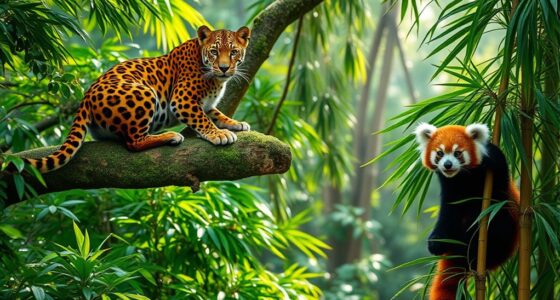Creating a wildlife-friendly garden starts with planting native species that fit your local soil and climate. Mix low, medium, and tall plants to support various wildlife and attract pollinators. Incorporate features like birdbaths, ponds, and dense shrubs for shelter and water. Avoid harmful chemicals and practice organic gardening to protect local ecosystems. Design your garden to allow safe animal movements and maintain year-round blooms. There’s so much more to explore about attracting wildlife and enhancing biodiversity!
Key Takeaways
- Select native plants that require less water and support local wildlife, ensuring a sustainable garden ecosystem.
- Create diverse habitats by mixing plant heights and including features like ponds or meadows for various species.
- Incorporate food sources, clean water features, and shelter options like dense shrubs and insect hotels for wildlife.
- Implement sustainable gardening practices, such as organic pest management and composting, to enhance soil health and reduce chemical use.
- Design gardens with wildlife corridors to facilitate safe movement and interaction among different species, promoting ecological balance.
The Importance of Wildlife-Friendly Gardens
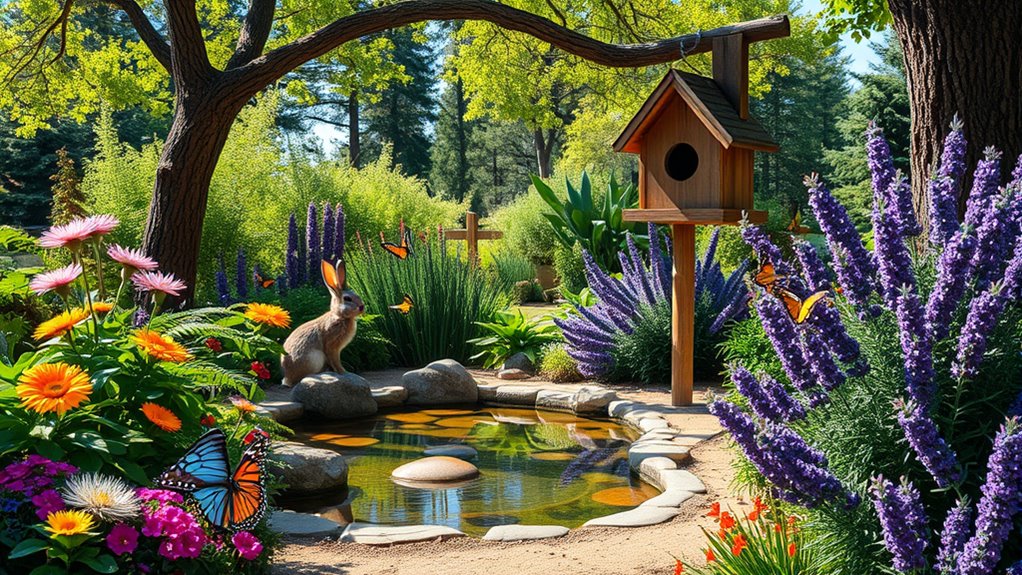
Creating a wildlife-friendly garden isn’t just about beautifying your space; it plays a crucial role in supporting biodiversity. By transforming your garden into a sanctuary, you help preserve ecosystem integrity and provide vital habitats for local wildlife. Many bird populations have suffered due to habitat loss, so your efforts can make a significant impact. Plus, these gardens often require less maintenance and reduce costs compared to traditional lawns. By incorporating features like ponds and layered habitats, you attract a variety of species, including essential pollinators like bees and butterflies. Additionally, having a sustainable environment enhances the resilience of local wildlife populations during crises. Furthermore, utilizing traditional healing practices in your garden design can create a deeper connection to the land, enriching both your gardening experience and the well-being of local wildlife. Implementing organic gardening practices also promotes biodiversity and the health of your garden ecosystem.
Ultimately, your garden not only enhances your environment but also fosters community awareness about the importance of conserving local ecosystems. Wildlife-friendly gardens play a key role in countering declining wildlife trends and contribute to conservation efforts. It’s a meaningful way to contribute to a healthier planet.
Selecting Native Plants for Your Garden
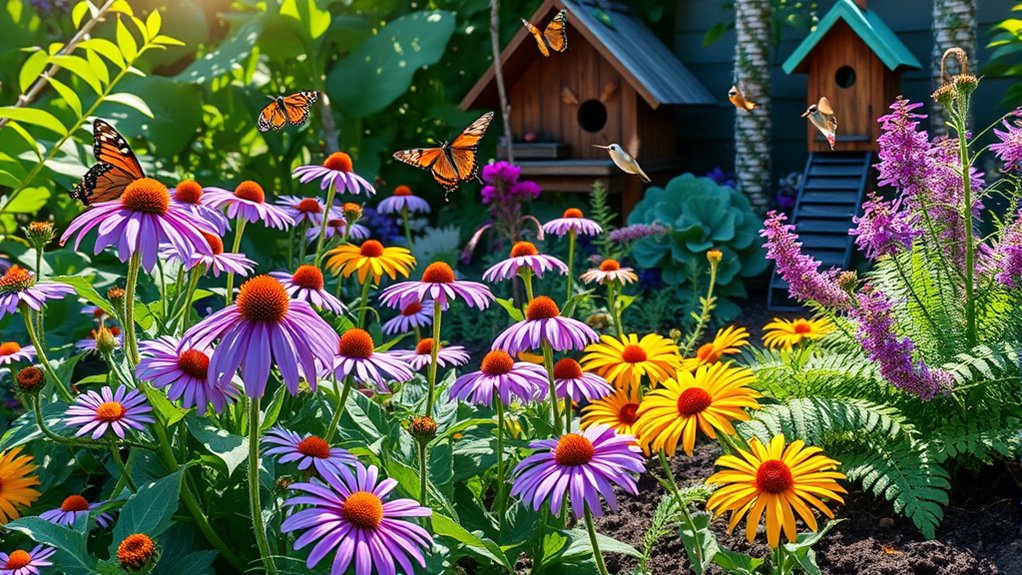
A wildlife-friendly garden thrives best with the right selection of native plants. These plants have evolved in your region, adapting to local soil and light conditions, which means they require less water and fertilizer.
By choosing native species, you’ll support biodiversity by providing essential food and shelter for local wildlife, such as birds and beneficial insects. Look for plants like milkweed for monarchs or wild indigo for pollinators. Additionally, native plants play an essential role in sustaining native insect populations, which are crucial for maintaining a balanced ecosystem. Incorporating self-watering planters can help maintain consistent moisture levels for these native plants, promoting their health and resilience. Furthermore, backyard greenhouses can help extend the growing season for these native plants, allowing them to thrive even in less-than-ideal conditions. Utilizing best waterwick pots can also enhance the growing process by ensuring that plants receive adequate moisture without frequent watering.
Incorporating a variety of native plants mimics natural ecosystems and encourages a wider range of wildlife. Remember to select plants specific to your area, avoiding hybrids, to ensure a thriving, sustainable garden that connects with your local environment and culture.
Creating Diverse Habitats
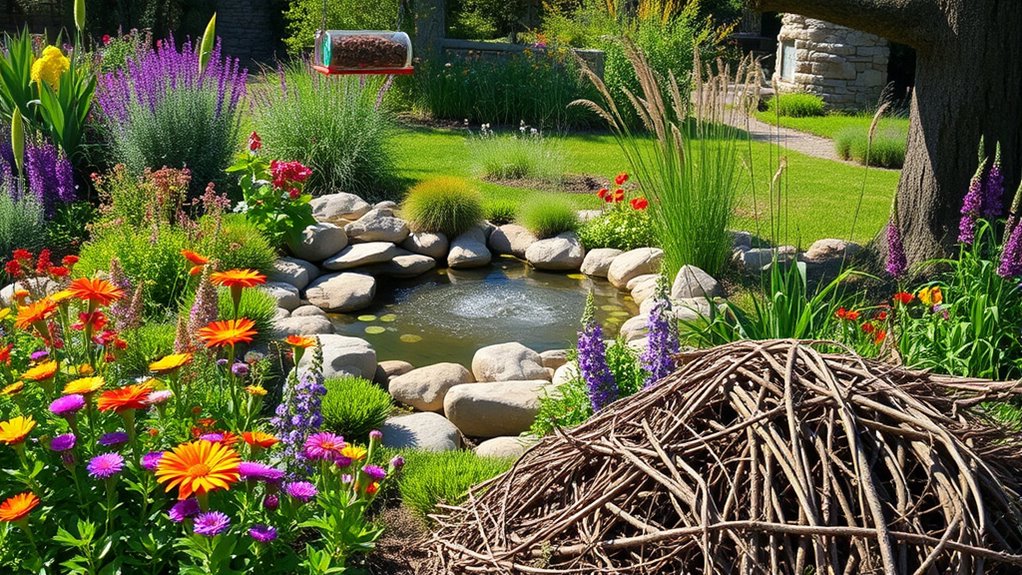
When you design a wildlife-friendly garden, incorporating diverse habitats ensures a thriving ecosystem.
Start by mixing low, medium, and tall plants to create visual interest and support various wildlife. Use native trees and shrubs for different heights, and add vines like honeysuckle for extra height and food sources. Mass plantings support pollinators by providing ample food sources, and plant diversity can also enhance resilience against pests and diseases. Additionally, ensuring proper indoor air quality in your garden can promote healthier plant growth, which in turn attracts more wildlife. Incorporating native plants can further enhance the garden’s appeal to local wildlife.
Ensure year-round blooms and colorful foliage to attract pollinators and provide food throughout the seasons. Create dense shrub layers for shelter and consider adding rock or log piles for additional hiding spots.
Install birdbaths or small ponds for water access, and keep these features clean to promote a healthy environment.
Essential Elements for Wildlife Habitats

To foster a thriving wildlife habitat, you’ll need to incorporate essential elements like food, water, shelter, and space.
Start by planting native plants that provide a variety of food sources throughout different seasons, ensuring biodiversity. In addition, consider incorporating historic love stories that showcase the connection between local culture and the natural environment.
Include clean water features, such as birdbaths or small ponds, keeping them well-maintained for drinking and bathing. Additionally, providing essential parenting resources can help educate families on the importance of maintaining a wildlife-friendly environment. Regularly updating these resources can also improve soil health by fostering a sustainable ecosystem.
For shelter, create dense shrubs, rock formations, and brush piles to protect wildlife from predators and harsh weather.
Ensure there’s enough space for animals to mark territory and reduce stress.
Finally, arrange these elements effectively, placing resources close together to minimize energy use and reduce competition among species. Habitat loss is the greatest threat to wildlife, so your thoughtful setup will create a balanced ecosystem that supports local wildlife.
Implementing Sustainable Gardening Practices
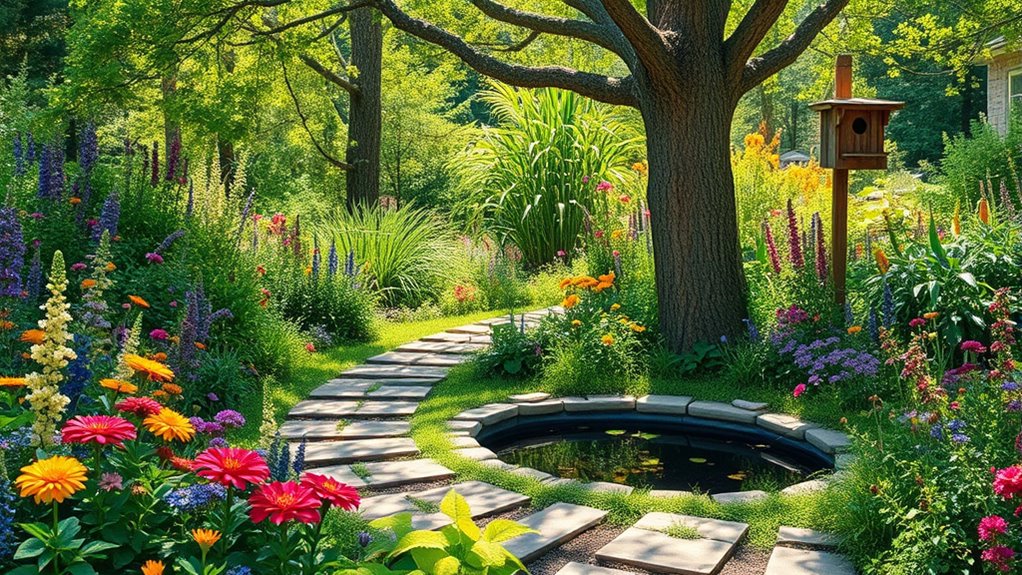
Implementing sustainable gardening practices not only benefits the environment but also enhances your garden’s resilience and productivity.
Start by using native plants; they require less water and maintenance while providing food and shelter for local wildlife. This approach fosters biodiversity and mimics natural habitats, supporting ecosystem balance. Restoration of wildlife habitat is essential for ensuring the survival of many species that rely on these spaces. Additionally, native plants can be rich in nutrients, which can further support local wildlife. Providing shelter for animals in your garden can also encourage a diverse range of species to thrive. Incorporating natural wonders into your garden design can enhance its beauty and ecological function.
To manage pests, avoid harmful chemicals and opt for organic methods like encouraging beneficial insects and companion planting.
Building healthy soil through compost and reducing tillage preserves structure and biodiversity.
Incorporate water conservation strategies, such as rainwater harvesting and drought-resistant plants, to minimize water use.
Balancing Human and Wildlife Needs

Creating a balance between human and wildlife needs in your garden is essential for fostering a thriving ecosystem. You can achieve this by incorporating native plants that support local wildlife while also selecting non-native options carefully. Native plants provide essential services that benefit both wildlife and human inhabitants. Moreover, zoning laws can influence how garden spaces are designed, especially in areas where regulations encourage wildlife-friendly practices. Urban areas like Harrisburg showcase how cultural festivals can raise awareness about creating wildlife-friendly environments.
Create diverse habitats, like ponds or meadows, to enhance biodiversity. Minimize hard surfaces to preserve wildlife habitats and accommodate seasonal changes that benefit animals year-round. The loss of entire species globally highlights the importance of creating spaces that promote biodiversity.
Reduce chemical use to protect wildlife health and allow some weeds to thrive, supporting the food chain. Adding features like insect hotels and water sources, while ensuring your garden remains aesthetically pleasing, can significantly improve the overall health of your garden ecosystem. Finally, consider wildlife corridors with gaps in fencing for hedgehogs, promoting safe movement and interaction among species.
Frequently Asked Questions
What Are the Best Times to Plant Native Species?
The best times to plant native species are spring and fall.
In spring, you can plant those that bloom in late summer or fall.
Fall’s warm soil helps roots grow while cooler air reduces water stress.
It’s especially good for perennials that bloom in spring, allowing them to establish before winter.
Early fall is perfect for ephemeral plants.
Timing your planting right ensures healthier plants and a more vibrant garden!
How Can I Attract Specific Wildlife to My Garden?
To attract specific wildlife to your garden, start by identifying the species you want to invite.
Incorporate native plants that provide food sources, and install features like bird feeders or ponds to meet their needs.
Create diverse habitats with shelter options, and ensure a consistent water supply.
Use chemical-free gardening practices to keep the environment healthy.
Are There Any Specific Tools for Wildlife Gardening?
Think of your garden as a stage, and the right tools are your cast. For wildlife gardening, you’ll need hand trowels for planting, pruning shears for maintaining health, and loppers for managing dense growth.
A weeding sickle helps clear unwanted plants, while shovels are perfect for digging ponds. Don’t forget a garden cart to transport materials!
With these tools, you can create an inviting haven for diverse creatures to thrive.
How Can I Monitor Wildlife Activity in My Garden?
To monitor wildlife activity in your garden, start by observing at various times of day.
Use apps like iNaturalist for species identification and set up wildlife cameras to capture elusive animals.
Keep a journal to document behaviors and interactions. Engage in citizen science projects, like the Great Backyard Bird Count, to contribute your findings.
Regularly assess plant and shelter options to ensure a thriving habitat that attracts diverse wildlife.
What Should I Do if I Find a Sick Animal?
If you find a sick animal, stay calm and avoid direct contact.
Observe the animal from a distance to assess its condition without causing stress. If it appears seriously ill, contact local animal control or a wildlife expert for guidance.
Use gloves if you must handle it, and ensure you document any symptoms you notice.
Conclusion
Creating a wildlife-friendly garden isn’t just good for nature; it enriches your own outdoor space. By selecting native plants, providing diverse habitats, and embracing sustainable practices, you can foster a thriving ecosystem right at home. Isn’t it rewarding to see butterflies, birds, and beneficial insects flourish in your garden? By balancing your needs with those of wildlife, you create a sanctuary that benefits both you and the environment. Start today, and watch your garden come alive!




